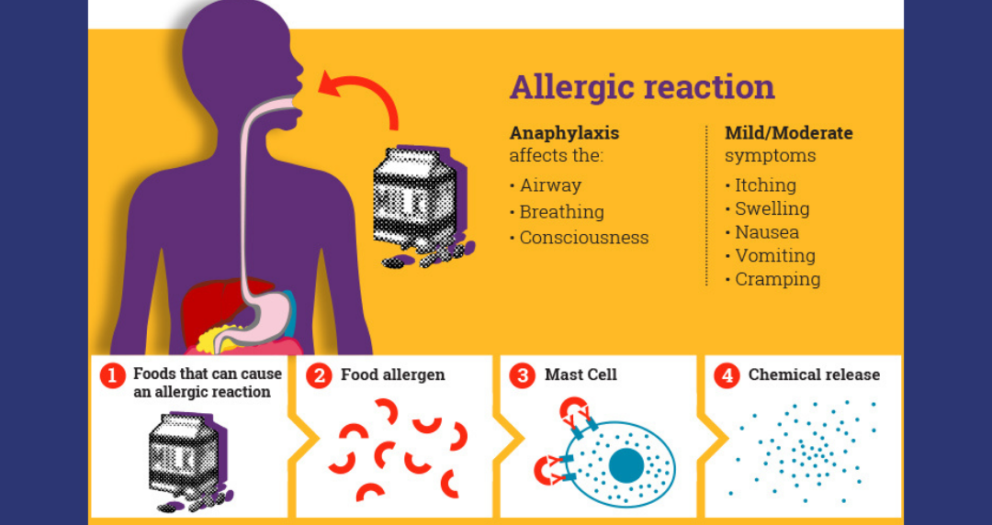Allergies are among the most common chronic health conditions worldwide, affecting millions of people across different age groups. An allergy occurs when the immune system reacts abnormally to a substance (an allergen) that is typically harmless to most people. These substances can include pollen, dust mites, animal dander, mold, certain foods, insect stings, and medications. The body’s immune response to these allergens can range from mild symptoms like sneezing and itching to more severe and even life-threatening reactions like anaphylaxis. Understanding the nature of allergies, their causes, symptoms, and management strategies is crucial for anyone looking to reduce their allergic reactions and improve their quality of life.
1. What is an Allergy?
An allergy is a condition in which the immune system mistakenly identifies a harmless substance as a dangerous invader. In response, the immune system releases chemicals like histamine to defend the body, resulting in allergic symptoms. Allergens are the substances that trigger this immune response, and they can enter the body through inhalation, ingestion, or direct contact.
The body’s immune system is designed to protect us from harmful substances like bacteria, viruses, and toxins. However, in individuals with allergies, the immune system overreacts to allergens, treating them as threats and launching a defense response. This can manifest in various ways, depending on the type of allergy and the severity of the reaction.
2. Common Allergens
Allergies can be triggered by a variety of substances, some of the most common being:
- Pollen: Pollen from trees, grasses, and weeds is a common cause of seasonal allergies (hay fever), especially during spring and fall.
- Dust Mites: These tiny organisms live in dust and feed on dead skin cells. They are common triggers for indoor allergies.
- Animal Dander: Proteins found in the skin, saliva, and urine of animals can cause allergic reactions, especially in people sensitive to cats or dogs.
- Mold: Mold spores can become airborne and trigger allergic reactions when inhaled.
- Food: Certain foods like peanuts, shellfish, milk, eggs, wheat, soy, and tree nuts are common allergens. Food allergies can lead to serious reactions, including anaphylaxis.
- Insect Stings: Bee, wasp, and ant stings can cause allergic reactions, ranging from mild swelling to severe anaphylaxis.
- Medications: Penicillin and other antibiotics, as well as aspirin and NSAIDs (nonsteroidal anti-inflammatory drugs), can trigger allergic reactions in some people.
- Latex: Found in products like gloves, balloons, and medical equipment, latex can cause allergic reactions ranging from skin irritation to severe respiratory symptoms.
3. Symptoms of Allergies
Allergic reactions can manifest in many ways depending on the type of allergen, the severity of the response, and the individual’s sensitivity. Symptoms may be mild in some cases, while severe reactions can be life-threatening. Common symptoms include:
- Sneezing: Commonly associated with allergies to pollen, dust, and animal dander, sneezing is one of the most recognizable allergy symptoms.
- Runny or Stuffy Nose: Nasal congestion often accompanies sneezing and is a hallmark of allergic rhinitis (hay fever).
- Itchy or Watery Eyes: Often triggered by pollen, pet dander, or dust mites, these symptoms are common in seasonal allergies.
- Skin Reactions: Hives (raised, red, itchy welts), eczema (dry, inflamed skin), or contact dermatitis can result from direct exposure to allergens like food, plants, or certain chemicals.
- Coughing, Wheezing, and Shortness of Breath: These symptoms are commonly associated with asthma or severe respiratory allergies and can occur when allergens like pollen, dust, or mold are inhaled.
- Abdominal Pain, Nausea, and Diarrhea: These gastrointestinal symptoms often occur with food allergies and can range from mild discomfort to severe reactions.
- Swelling: Swelling of the lips, tongue, throat, or face is a more severe symptom that can accompany food, drug, or insect sting allergies. It may signal the onset of anaphylaxis, a life-threatening condition.
4. Anaphylaxis: The Most Severe Allergic Reaction
Anaphylaxis is the most serious allergic reaction and requires immediate medical attention. It is a rapid and systemic response that affects multiple organs in the body. Common triggers of anaphylaxis include certain foods, insect stings, medications, and latex. Symptoms of anaphylaxis may include:
- Difficulty breathing due to swelling of the throat or narrowing of the airways
- A sudden drop in blood pressure (anaphylactic shock)
- Rapid pulse or palpitations
- Swelling of the face, lips, and tongue
- Confusion, dizziness, or loss of consciousness
The primary treatment for anaphylaxis is the administration of epinephrine (adrenaline), typically via an auto-injector (such as an EpiPen). After receiving epinephrine, it is essential to seek emergency medical care, even if symptoms seem to improve, as a second wave of the reaction (biphasic anaphylaxis) can occur.
5. Types of Allergies
There are several types of allergies, each associated with different triggers and symptoms. The most common types include:
- Allergic Rhinitis (Hay Fever): This type of allergy is triggered by airborne allergens such as pollen, dust mites, and pet dander. It causes symptoms like sneezing, a runny nose, and itchy eyes, and is often seasonal, coinciding with high pollen levels during spring and fall.
- Food Allergies: Food allergies occur when the immune system reacts to certain foods. Even a small amount of the food can trigger a reaction. Symptoms can range from mild itching to anaphylaxis.
- Asthma: Asthma is a chronic respiratory condition that is often triggered by allergens such as pollen, dust mites, mold, and pet dander. Asthma symptoms include coughing, wheezing, chest tightness, and shortness of breath.
- Skin Allergies: These include conditions like eczema (atopic dermatitis), hives (urticaria), and contact dermatitis, where the skin becomes inflamed, red, and itchy after exposure to an allergen.
- Drug Allergies: Some people have allergic reactions to medications like antibiotics or nonsteroidal anti-inflammatory drugs (NSAIDs). Symptoms can range from mild rashes to severe reactions like anaphylaxis.
- Insect Sting Allergies: Insect stings can cause a range of allergic reactions, from localized swelling to severe anaphylaxis, particularly in individuals allergic to bee, wasp, or ant venom.
6. Diagnosis of Allergies
Diagnosing allergies typically involves a combination of medical history, physical examination, and allergy testing. Some common methods of diagnosing allergies include:
- Skin Prick Test: In this test, small amounts of potential allergens are applied to the skin, which is then pricked or scratched. If an allergic reaction occurs (such as swelling or redness), the test is positive for that allergen.
- Blood Tests: Blood tests, like the radioallergosorbent test (RAST), measure the level of IgE antibodies in response to specific allergens.
- Patch Testing: Patch testing is used to diagnose contact dermatitis. Small patches containing different substances are applied to the skin to see if any reactions occur over the course of a few days.
- Food Challenge: For food allergies, an oral food challenge might be conducted under medical supervision to confirm a diagnosis.
7. Managing and Treating Allergies
While there is no cure for allergies, they can be effectively managed through avoidance strategies, medications, and sometimes immunotherapy.
- Avoidance: The best way to manage allergies is to avoid the allergen whenever possible. This can involve making adjustments at home, such as using air purifiers, washing bedding frequently, and avoiding outdoor activities when pollen levels are high.
- Medications: Over-the-counter antihistamines, decongestants, and corticosteroids can help control mild allergy symptoms. For more severe cases, doctors may prescribe stronger medications or epinephrine for emergencies.
- Immunotherapy: Allergy shots or sublingual tablets (placed under the tongue) are forms of immunotherapy that gradually desensitize the immune system to specific allergens over time. This can be especially effective for pollen, dust mite, or insect sting allergies.
8. Living with Allergies
Living with allergies requires understanding your triggers and being proactive in managing symptoms. Educating yourself and others about your allergies, knowing how to avoid allergens, and having an emergency plan in place (such as carrying an epinephrine auto-injector) are all essential steps in managing life with allergies.
Conclusion of Article:-
Allergies are a widespread and varied condition that can range from mild annoyances to life-threatening emergencies. Understanding the common allergens, recognizing the symptoms of an allergic reaction, and knowing how to treat and manage allergies is crucial for improving quality of life. With the right strategies in place, many people with allergies can minimize their symptoms and live comfortably despite their condition. Whether through avoidance, medication, or immunotherapy, managing allergies is a lifelong process that requires vigilance and awareness, but it is also highly effective with proper care and attention.




Write a comment
Your email address will not be published. All fields are required